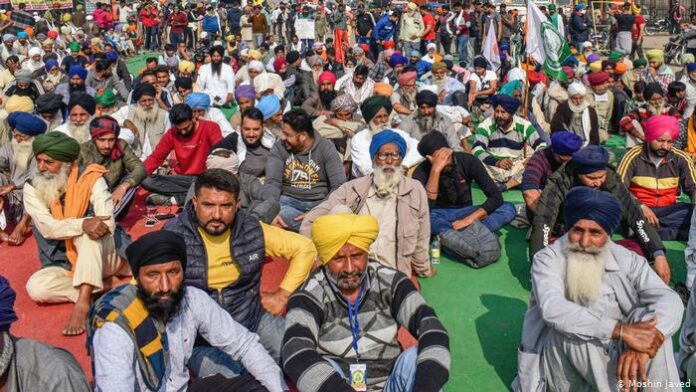The coronavirus has already pushed the Indian economy into a deep contraction. An ongoing farmers’ protest against new agricultural laws threatens to exacerbate the economic malaise.
Protesters blocked a train Tuesday in during an ‘all India’ strike supporting farmers
For nearly two weeks, tens of thousands of farmers have been staging protests on roads leading into Delhi. The farmers want to pressure Indian Prime Minister Narendra Modi into repealing a new set of farming laws, which they say liberalizes the agriculture market at farmers’ expense.
On Tuesday, the farmers called for a nationwide shutdown, which closed businesses and disrupted traffic as protesters squatted on roads and train tracks in several parts of the country.
The impact of the shutdown, which was called “Bharat Bandh,” was particularly strong in northern states like Punjab and Haryana, and the capital region, Delhi.
Indian farmers launch nationwide strike
Industry in Punjab, already reeling under the disruption of coronavirus lockdowns, has been doubly hit as train services remain suspended by the protests.
“This protest has lasted for a long time and has begun eating up the economy of the state,” Badish Jindal, president of Punjab’s federation of small businesses, told DW.
Making a bad economic situation worse
Last week, India’s central bank, the Reserve Bank of India, predicted India’s economy will contract by 9.5% in the current fiscal year, which ends on March 31, 2021.
In the April-June quarter of 2020, when the lockdown was in full force, India’s economy contracted by nearly a quarter, which is the worst-ever decline since India started compiling GDP statistics on a quarterly basis in 1996.
Economists and policy analysts believe the ongoing disruption caused by the protests could further upset the already fragile economic situation.
“Obviously, this strike will have repercussions. Agricultural supply has already dipped and this will lead to inflation. Agrarian distress will be further compounded,” as Jawaharlal Nehru University economist Himanshu — who only goes by one name — told DW.
Agriculture accounts for nearly 15% of India’s 2.4 trillion-euro economy, and farmers’ unions are a powerful political constituency.
Although most economists are reluctant to estimate a ballpark figure on the economic losses brought on by the demonstrations, some pointed out that the effects will likely extend beyond the agriculture sector into the overall economy.
“At a time when the economy is upended and lives and livelihoods are affected, this current impasse will add further distress. It is difficult to estimate the production loss, but all of this will have a ripple effect,” Mahesh Vyas, CEO of the Centre for Monitoring Indian Economy (CMIE), told DW.
“A contraction in the Indian economy would continue into the next three quarters and a recession is inevitable,” he added.
Strikes in India can be expensive
A nationwide strike of trade unions in 2015 hit banking and other services. The overall loss to the economy was pegged by chambers of commerce to be around €2.8 billion ($3.3 billion).
The overall loss rippled into manufacturing, industry, trade and transport.
Although Tuesday’s strike did not completely paralyze life in India, nearly 475 farmers’ organizations, trade unions, small shopkeepers and landless laborers joined in, accounting for numerous direct and indirect losses.
“The protests are going on in every state. Surely there have been disruptions, as many constituents across the country have come forward to express solidarity,” All India Peasants Union General Secretary Hannan Mollah, told DW.
Small farmers pay a price
Talks between the government and representatives of the farmers have failed to break the deadlock, as farmers refuse to accept anything less than the scrapping of the three laws and assurances of a guaranteed minimum support price (MSP) for their produce.
Given that more than half of India’s 1.3 billion plus population works in the agriculture sector, millions of small-scale farmers have lost their incomes due to falling prices of their crops and rising transportation and storage costs.
Small-scale farms face an ongoing crisis, and many thousands of debt-ridden farmers have taken their own lives.
“Punjab has been the food bowl of India. All these years, Punjab has contributed the largest amount of food grain to the central pool,” Pramod Kumar, director of India’s Institute for Development and Communication (IDC), told DW.
“The possible withdrawal of the protective cover provided by the MSP is seen as an act of betrayal here,” he added.
DW

